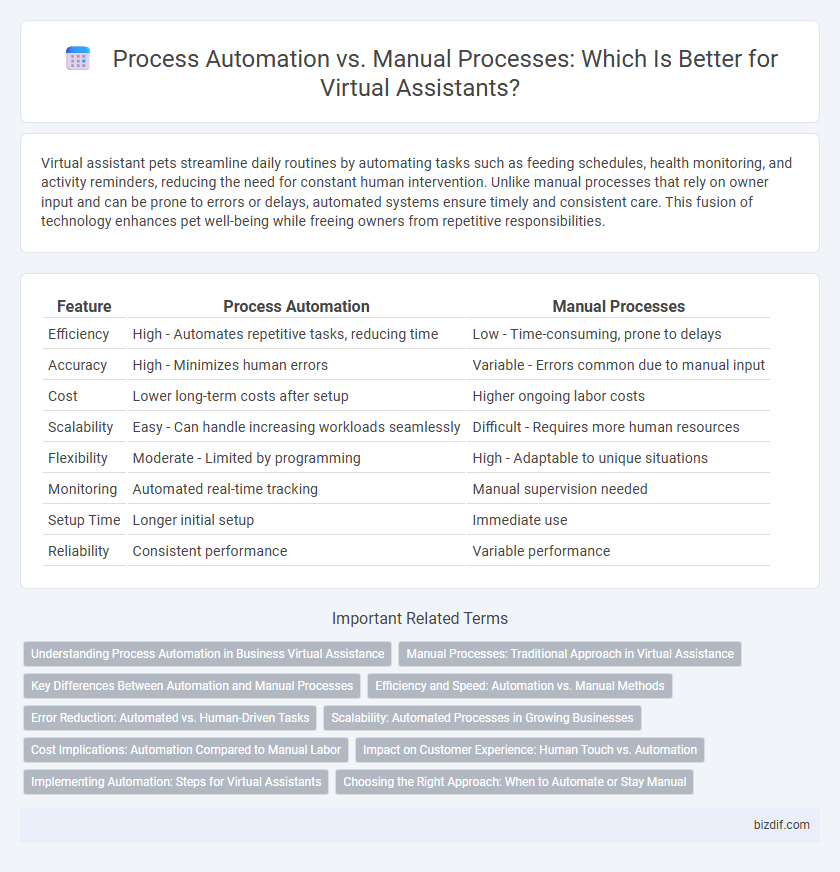Virtual assistant pets streamline daily routines by automating tasks such as feeding schedules, health monitoring, and activity reminders, reducing the need for constant human intervention. Unlike manual processes that rely on owner input and can be prone to errors or delays, automated systems ensure timely and consistent care. This fusion of technology enhances pet well-being while freeing owners from repetitive responsibilities.
Table of Comparison
| Feature | Process Automation | Manual Processes |
|---|---|---|
| Efficiency | High - Automates repetitive tasks, reducing time | Low - Time-consuming, prone to delays |
| Accuracy | High - Minimizes human errors | Variable - Errors common due to manual input |
| Cost | Lower long-term costs after setup | Higher ongoing labor costs |
| Scalability | Easy - Can handle increasing workloads seamlessly | Difficult - Requires more human resources |
| Flexibility | Moderate - Limited by programming | High - Adaptable to unique situations |
| Monitoring | Automated real-time tracking | Manual supervision needed |
| Setup Time | Longer initial setup | Immediate use |
| Reliability | Consistent performance | Variable performance |
Understanding Process Automation in Business Virtual Assistance
Process automation in business virtual assistance streamlines repetitive tasks such as scheduling, data entry, and customer inquiries, reducing human error and increasing efficiency. Virtual assistants leverage AI and machine learning algorithms to execute these automated workflows, enabling faster response times and consistent performance. Businesses that adopt process automation experience improved resource allocation and cost savings compared to relying solely on manual processes.
Manual Processes: Traditional Approach in Virtual Assistance
Manual processes in virtual assistance rely heavily on human intervention for tasks such as scheduling, data entry, and customer support, often resulting in slower response times and increased risk of errors. This traditional approach requires continuous monitoring and repetitive input, which limits scalability and efficiency. Despite its familiarity, manual handling lacks the precision and speed offered by automated systems, impacting overall productivity and customer satisfaction.
Key Differences Between Automation and Manual Processes
Process automation leverages software and artificial intelligence to execute repetitive tasks efficiently, reducing human errors and increasing productivity, while manual processes rely on human intervention, which is often slower and prone to mistakes. Automation provides consistent output, scalability, and real-time monitoring, whereas manual operations limit scalability and lack real-time data insights. Key differences include speed, accuracy, cost-effectiveness, and the ability to handle complex workflows without constant supervision.
Efficiency and Speed: Automation vs. Manual Methods
Process automation significantly enhances efficiency and speed by executing repetitive tasks with precision and minimal delay, reducing the risk of human error common in manual processes. Virtual assistants leverage advanced algorithms and machine learning to streamline workflows, enabling faster data processing and decision-making compared to manual input and handling. Automation increases productivity by allowing businesses to allocate human resources to higher-level strategic activities while routine tasks are managed autonomously.
Error Reduction: Automated vs. Human-Driven Tasks
Automated processes in virtual assistant systems significantly reduce errors compared to human-driven tasks by eliminating manual input inconsistencies and fatigue-related mistakes. Machine learning algorithms and rule-based automation ensure higher accuracy and faster task completion, enhancing overall operational efficiency. Manual processes remain prone to human error, leading to increased rework and delays, especially in repetitive workflows.
Scalability: Automated Processes in Growing Businesses
Automated processes enable scalable operations by handling increasing workloads without proportional increases in time or resources, unlike manual processes that become bottlenecks as businesses grow. Virtual assistants streamline repetitive tasks such as scheduling, data entry, and customer inquiries, allowing companies to allocate human resources to strategic activities. This scalability improves efficiency, reduces errors, and supports consistent service quality in expanding organizations.
Cost Implications: Automation Compared to Manual Labor
Process automation significantly reduces operational costs by minimizing human error and increasing task efficiency, leading to lower labor expenses and faster turnaround times. Manual labor often incurs higher costs due to repetitive task management, longer completion times, and increased risk of mistakes requiring costly corrections. Investing in virtual assistant-driven automation enhances scalability and cost-effectiveness, providing substantial ROI compared to traditional manual processes.
Impact on Customer Experience: Human Touch vs. Automation
Process automation enhances customer experience by delivering faster response times and consistent service quality, reducing errors common in manual processes. However, manual processes provide the human touch necessary for complex issue resolution and emotional understanding, fostering trust and customer loyalty. Balancing automation with personalized human interaction creates a seamless experience that meets efficiency demands while maintaining empathy and connection.
Implementing Automation: Steps for Virtual Assistants
Implementing automation for virtual assistants begins with identifying repetitive tasks suitable for automation, such as scheduling, data entry, and email management. Next, selecting and integrating appropriate automation tools with existing systems maximizes efficiency and minimizes errors. Continuous monitoring and refining of automated workflows ensure optimal performance and adaptability to changing business needs.
Choosing the Right Approach: When to Automate or Stay Manual
Automating repetitive tasks using virtual assistants increases efficiency by reducing errors and saving time, especially in high-volume workflows like customer support or data entry. Manual processes remain valuable when tasks require complex decision-making, human judgment, or personalized interactions that automation cannot replicate. Evaluating task complexity, frequency, and the need for customization helps determine whether to implement process automation or maintain manual handling for optimal results.
Process Automation vs Manual Processes Infographic

 bizdif.com
bizdif.com